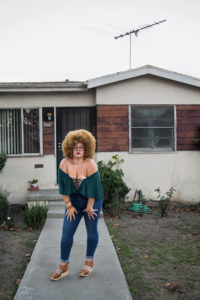Your cart is currently empty!
Genevieve Gaignard

Although Genevieve Gaignard’s fair complexion and red hair enabled her to blend in with her white contemporaries while growing up in a Massachusetts’ mill town, her solo show at the California African American Museum reflects the internal conflict she experienced while trying to navigate her identity as a biracial woman. A combination of installation, assemblage and photographic self-portraiture, “Smell the Roses” reads like a scrapbook, reflective of Gaignard’s search for identity through an exploration of convenient American stereotypes.
Entering the show, viewers confront two installations. One represents Gaignard’s father’s childhood home, the other the artist’s adolescent bedroom. Both spaces appear eerily immaculate, like rooms in an abandoned dollhouse. Of note are the props on display. Most play to antiquated and obvious generalizations often associated with black stereotypes. For example, a container of Crisco, a box of jambalaya mix and a can of black eyed peas stock a kitchen cupboard in the first installation while a bottle of cocoa butter, an afro pick and other ethnic beauty products decorate the second. These legacy-branded set decorations obviously speak to Gaignard’s heritage–possibly with an excess of familiarity. Yet at the same time, their inclusion gives viewers reason to pause and consider the conflicted nature of “passing” while struggling to reconcile one’s ties to black culture.

Like her installations, Gaignard’s assemblages comprise an assortment of artifacts that address the mixed-race dilemma. In We are only as blind as we want to be (all works 2016) and The Black Woman, copies of Alex Haley’s Roots, Richard Wright’s Uncle Tom’s Children and Barrack Obama’s Dreams from My Father appear on wall-mounted shelving units along with an assembly of knickknacks including a Blackamoor Mammy, vintage spray atomizers, and a figurine of a blond girl looking at herself in the mirror.
Of all Gaignard’s modes of expression, her photographic self-portraits depicting a diverse range of American female stereotypes prove the most provocative. Like Hassan Hajjaj’s highly stylized photographs, Gaignard’s self-portraits accurately capture the various nuances that characterize each of her subjects. In Red State, Blue Plate, she holds a cigarette in one hand and a “40” in the other while seated with her legs spread on the hood of a red 1990s sub-compact. In Basic Cable & Chill, she sports an afro, gold hoops and a more than revealing neckline while assuming a sultry pose on the front walkway of a run-down tract house. And in Extra Value (After Venus), she wears a cut-off tee shirt announcing “Thug Life” along with a pair of unbuttoned acid-wash jeans that reveal her protruding midriff while mugging in front of an American flag.
Not only do Gaignard’s self-portraits confront issues concerning race, but they also touch upon femininity, body image and class with a bold and at times crass vigor that doesn’t manifest in her other works with the same intensity. Rather, they resonate with an astute potency all on their own, aptly representative of the many roles with which Gaignard has identified while trying to discover her own uniqueness.